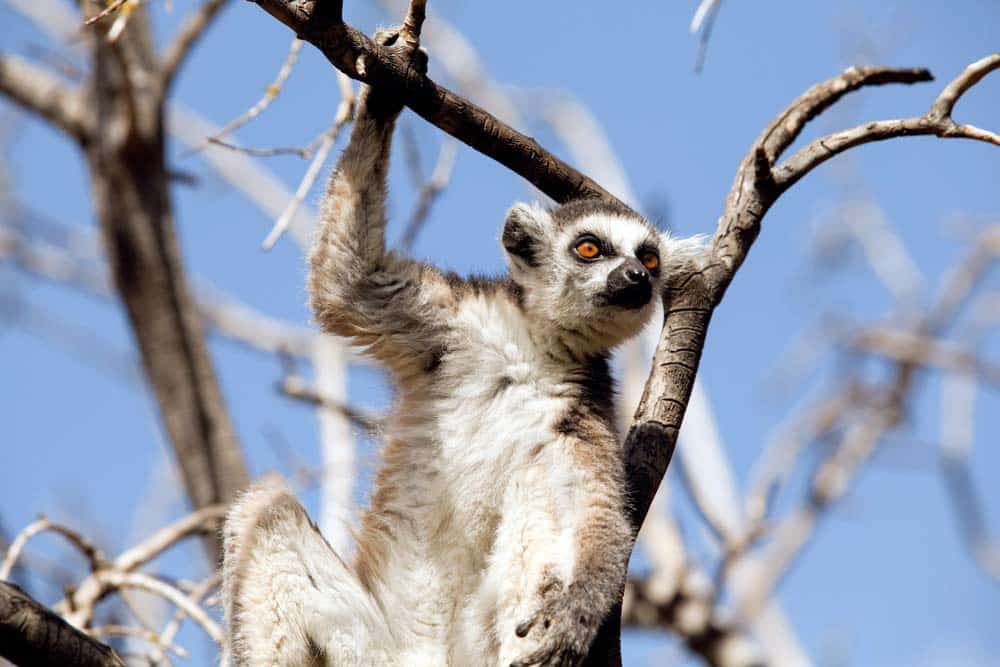In southwestern Madagascar, we explore natural spaces in their almost pristine condition and meet the Mikea people, who live autonomously like in the time of hunters and gatherers in an arid area with dry forests and thorny thickets.
The red island is one of the few countries on our planet that has preserved so much authenticity. The charm and friendliness of its population are matched only by the beauty of its landscapes and coastline. From Toliara in the south, we travel inland to the canyons of Isalo National Park as well as to the sea, where the Vezo fishermen live, who face the waves of the Indian Ocean breaking on the coral reef with their canoes.
There isn’t the slightest breeze, the sun burns hot on the skin. The silence is complete. No noise, no birdsong. On the dry limestone ground, one can move around easily on foot between the thorny bushes, shrubs and small trees. Madagascar’s southwest is indeed very dry. 3,600 hours of sunshine and less than 600 mm of rain per year, with temperatures fluctuating between 27°C and 32°C year-round, have shaped this low, dry, sparse vegetation, which stands in stark contrast to the lush rainforests in the north.

Suddenly there’s a rustling. We hold our breath. There sit a man and a woman, both almost naked, with two girls of toddler age, who are also naked. They belong to the ethnic group of the Mikea, who live completely autonomously in this desolate bush area. It is impossible to determine their age. They themselves do not know when they or their children were born. “They do not count the moons,” explains the guide, who speaks the Masikoro dialect.
This family accepts contact with strangers, but most Mikea do not leave the protection of their forest. During the day, they search for food on foot, mainly berries and honey. Sometimes they catch a helmeted guinea fowl with a snare made of leaf veins, very rarely even a wild boar. They do not build huts, no shelter, do not breed animals, do not cultivate anything. When it’s too cold, they dig a hole in the sandy soil to sleep in, but that’s all. To make fire, they rub sticks together. They own nothing except a flint and a pipe.
They are true hunters and gatherers who navigate this bush landscape with the help of the compass tree, the “Sono”, a tall plant with long thorns (Didierea madagascariensis), whose shoots are bent by the south wind and thus always indicate north.
And when they are thirsty? Water-filled roots (yam roots, Dioscorea sp.), which can be eaten raw, provide the necessary fluid. Or they drill holes in the trunk of a baobab to draw water from it. The sap that flows from the tree would make most Madagascans ill, but the organisms of the Mikea have been accustomed to it for dozens of generations. But do not believe that these hunters and gatherers are the survivors of primordial generations. They are the descendants of those who, about 200 years ago, fled from the harassment of their oppressors, hid in this forest and decided not to leave it again.
THE BLUE CONTRAST
The blue mosaic of the Indian Ocean, a twenty-minute walk away, seems almost surrealistic. The power of the waves, the spray, the dunes, the square sails of the outrigger canoes on which the Vezo fishermen transport their goods, bring us back to reality. The boats are fully loaded with mangoes, bananas, pineapples. An astonishing contrast when one considers that the Mikea never come here and never taste these fruits.
This southern coast is simply magical. The purity of the white sand is incomparable. The warm water is inviting. It is beautiful, enchanting, photogenic. An ideal place for a holiday for two. When the sun sinks below the horizon, behind the smooth surface of the ocean, look out for the green ray that Jules Verne so loved, a small green flash that sometimes appears at the top of the sun as it sinks into the sea. It is incredibly romantic to wait for this rare phenomenon.

The few, small hotels are perfectly integrated into the landscape. Getting there requires patience. There is no paved road, but the paths can be managed with a jeep. It takes about four to five hours to reach the nearest tourist facility.
The reward? A sense of solitude, freedom and fulfilment, a Robinson Crusoe ambiance with the classic comfort (food, room, bathroom) that we are accustomed to.
NATURE
On the way back, a stop in the town of Mangily north of Toliara is recommended. Reniala, the “Mother of the Forest”, is what the Madagascans call the centuries-old tree that is the symbol of their island: the baobab. With its round trunk and branches that look like roots growing from the top of its trunk, the baobab is unmistakable. The sixty-hectare Reniala nature reserve has countless remarkable baobabs, which sometimes have quite curious shapes in which a symbolism can even be recognised: a baobab in love, intertwined with another, baobabs that look like teapots, corsets or rhinoceroses. You can also see lemurs like the ring-tailed lemur, a beautiful fruit-eater with a long black and white ringed tail. The park’s Lemur Rescue Centre, in partnership with French zoos under the patronage of the Brigitte Bardot Foundation, takes in lemurs that are prepared here for life in the wild.

A few hours’ drive further, the scenery changes. Canyons, small sandstone mountains whose peaks do not exceed the 1,200-metre mark. Isalo National Park is a must-visit for tourists from all over the world.
Hiking, horseback riding, observing birds or endemic species (lemurs, chameleons, reptiles…), bathing in the springs are just some of the many possible activities. Those who don’t mind the effort can try the via ferrata course or undertake a multi-day mountain biking or trekking tour.
In the evening, when countless stars shine in the deep blue sky and the Milky Way stands out against the complete darkness, we are filled with a blissful feeling of contentment. No noise, no sources of light, just the unique spectacle of magnificent nature. Between the reddish ochre of Isalo Park, the emerald and turquoise glitter of the Indian Ocean, and the moss-green thorn forests, Madagascar, the land of contrasts, keeps all its promises. And much more.

Practical Travel Information
Accommodation
Mikea Lodge. Charming bungalows with open-air shower and WC, overlooking the baobabs and the Indian Ocean.
Accommodation in Isalo
The Satrana Lodge at the entrance to the National Park on the edge of the RN7 offers 40 luxurious tent accommodations. African safari ambiance with bar and pool.
Restaurant
Le Jardin de Giancarlo, in Toliara. The incredible and delicious culinary variety is served under the direction of the Italian Giancarlo in an eclectic decor of paintings by local artists.
Useful information
Website of the Madagascar Tourist Office.
Author: Martine Carret
